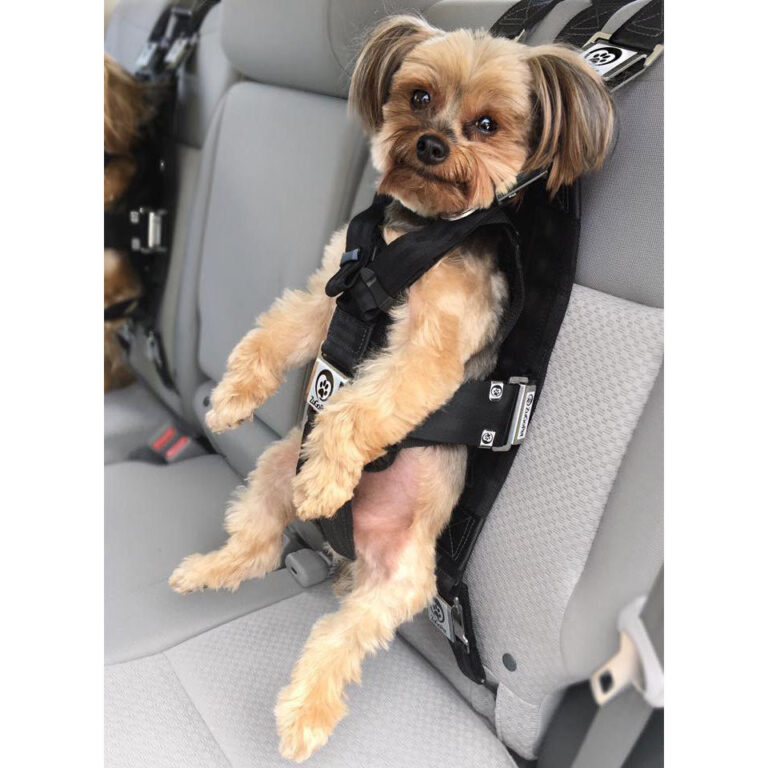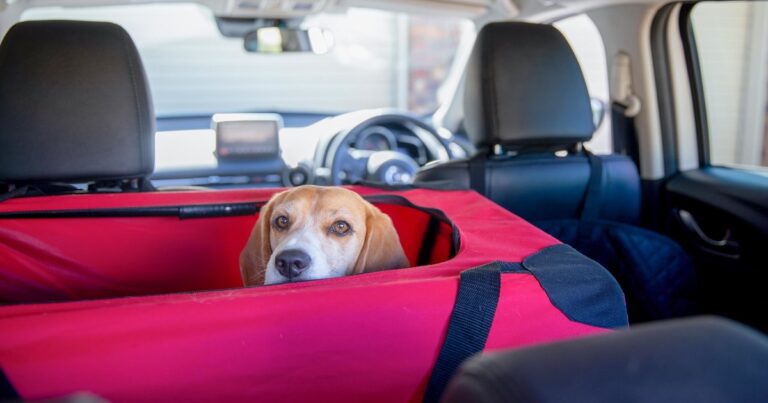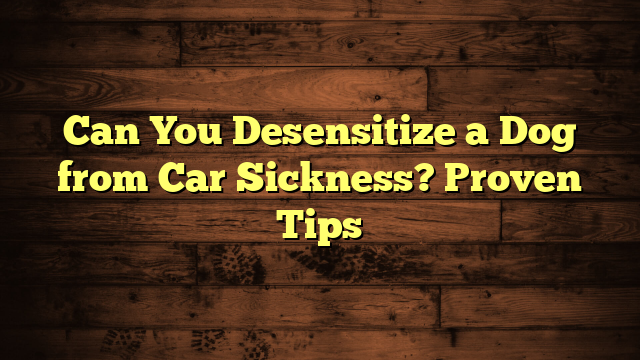How to Secure a Dog in a Car With a Leash? Safe & Simple
To secure a dog in a car with a leash, attach the leash to a sturdy harness. Clip the other end to the seat belt.
Traveling with your dog can be a joyful experience, but safety is paramount. Properly securing your dog in the car ensures both their safety and yours. Using a leash in combination with a harness and seat belt is an effective method.
This approach prevents the dog from moving around too much or becoming a projectile in case of sudden stops. It also helps to minimize distractions, allowing you to focus on the road. Always choose high-quality, durable equipment to ensure the best protection for your furry friend. Ensuring your dog is securely fastened will make every trip safer and more enjoyable.
Introduction To Dog Safety In Vehicles
Ensuring the safety of your dog during car rides is crucial. Dogs, like humans, need proper restraints to stay secure. This blog post will guide you on how to secure a dog in a car with a leash.
Importance Of Securing Your Pet
Securing your dog in a car is essential for multiple reasons. It prevents distractions while driving. An unrestrained dog can cause accidents. It protects your pet from sudden stops or collisions. Proper restraint keeps your dog safe and comfortable during travel.
Here are some key benefits of securing your dog:
- Prevents distractions: A restrained dog won’t jump around or interfere.
- Reduces injury risk: In case of an accident, your dog remains safe.
- Legal compliance: Some places require pets to be secured by law.
Risks Of Unrestrained Dogs
Unrestrained dogs in cars pose several risks. They can cause accidents by distracting the driver. They can suffer injuries during sudden stops. They can become projectiles in a collision, injuring themselves and passengers.
Here is a table summarizing the risks:
| Risk | Description |
|---|---|
| Distraction | An unrestrained dog can jump around and distract the driver. |
| Injury | Sudden stops or accidents can cause severe injuries to unrestrained dogs. |
| Projectile | An unrestrained dog can become a projectile during a crash. |
Keep your dog and yourself safe by using a proper leash and restraint system. Safety should always be a priority during travel.

Credit: slowtonglobal.com
Types Of Dog Restraints For Cars
Ensuring your dog’s safety in the car is essential. There are many options to keep them secure. Here are the types of dog restraints for cars you can use:
Harnesses And Seat Belts
A dog harness is a comfortable option. It wraps around the dog’s chest and back. Attach the harness to the car’s seat belt system. This keeps your dog secure and comfortable.
Dog seat belts are another choice. These belts clip onto a harness and the car’s seat belt buckle. They allow some movement but prevent sudden jumps or accidents. Both harnesses and seat belts come in various sizes and designs. Choose one that fits your dog snugly.
| Type | Features | Benefits |
|---|---|---|
| Harness | Wraps around chest and back | Comfortable and secure |
| Seat Belt | Clips onto harness and buckle | Prevents sudden movements |
Barriers And Crates
Dog barriers are great for larger cars. They fit between the front and back seats. This keeps your dog in the back seat area. Barriers are easy to install and remove. They also allow your dog to move around a bit.
Crates offer maximum security. They come in various sizes. Place the crate in the back seat or the cargo area. Make sure the crate is well-ventilated and comfortable. Add a blanket or cushion for extra comfort.
- Barriers keep dogs in the back seat.
- Crates provide maximum security.
| Type | Features | Benefits |
|---|---|---|
| Barrier | Fits between seats | Allows some movement |
| Crate | Enclosed space | Maximum security |
Choosing The Right Leash And Harness
Securing your dog in the car ensures their safety during travel. Choosing the right leash and harness is crucial. This section will guide you through selecting the best options. Focus on material, durability, fit, and comfort for your furry friend.
Material And Durability
The material of the leash and harness is important for safety. Nylon and leather are popular choices. Nylon is durable and easy to clean. Leather provides a classic look and is very sturdy. Both materials have their pros and cons.
Consider a harness with reinforced stitching. This adds extra durability. A strong metal buckle is also essential. Avoid plastic buckles as they can break easily.
Check the leash’s thickness and strength. Thicker leashes are generally more durable. Make sure the leash can handle your dog’s weight and strength.
Fit And Comfort For Your Dog
The harness should fit snugly but not too tight. Use a measuring tape to get your dog’s chest and neck size. Refer to the manufacturer’s sizing chart for accuracy.
A good harness should have adjustable straps. This ensures a perfect fit. Look for padded areas on the harness. Padding provides extra comfort for your dog during long trips.
The leash should also be comfortable to hold. Some leashes come with padded handles. This reduces strain on your hands during walks.
| Feature | Recommendation |
|---|---|
| Material | Nylon or Leather |
| Durability | Reinforced Stitching, Metal Buckles |
| Fit | Snug, Adjustable Straps |
| Comfort | Padded Areas, Padded Handles |
Ensuring your dog is secure and comfortable will make car rides safer and more enjoyable. Choose wisely and always check the fit before starting your journey.
Step-by-step: Securing Your Dog With A Leash
Ensuring your dog is safely secured in a car is crucial for their safety and your peace of mind. Using a leash can be a simple and effective way to keep them secure. Follow these steps to make sure your furry friend is safe during car rides.
Attaching The Leash To The Harness
First, choose a sturdy harness designed for dogs. Avoid using a collar for securing your dog as it can cause injuries.
Once you have the right harness, put it on your dog. Make sure it fits snugly but not too tight. You should be able to slide two fingers between the harness and your dog’s body.
Next, attach the leash to the harness. Ensure that the clip is securely fastened to the D-ring on the harness. Tug gently on the leash to check that it is firmly attached.
Securing The Leash To The Vehicle
Find a secure point in your car to attach the leash. This could be a seatbelt or a designated dog seatbelt attachment.
Loop the leash around the secure point and clip it back onto itself. This will create a strong anchor point for the leash.
Make sure the length of the leash allows your dog to sit or lie down comfortably. They should not be able to move around too much. This will keep them secure during the car ride.
Double-check the setup before starting your journey. Ensure that the leash is tight and the harness is secure. Your dog should not be able to reach the front seat.
With these steps, you can keep your dog safe and secure during car rides. Happy traveling with your furry friend!
Safety Checks Before You Drive
Ensuring your dog’s safety in the car is very important. Before you start driving, perform a few quick checks. These simple steps can save your pet’s life. Let’s explore the key points.
Harness Fit And Leash Stability
Check the harness fit. It should be snug but not too tight. You should be able to slide two fingers under the harness.
Ensure the leash is stable. Attach it securely to the car’s seatbelt. This will prevent your dog from moving around too much.
Make sure the leash length is appropriate. It should allow some movement but not too much. This will keep your dog safe during sudden stops.
Removing Potential Choking Hazards
Remove any loose objects from the car. These can become choking hazards. This includes toys, bones, and other small items.
Check for loose collars or tags. These can get caught and cause choking. Make sure everything is secure.
Inspect the car seats and floor. Ensure there are no items your dog can chew on. This will help avoid choking incidents.
| Checklist | Action |
|---|---|
| Harness Fit | Snug but comfortable |
| Leash Stability | Secure to seatbelt |
| Leash Length | Allow limited movement |
| Loose Objects | Remove from car |
| Collars/Tags | Secure and check |
Training Your Dog To Ride Safely
Training Your Dog to Ride Safely is crucial for both your pet’s safety and your peace of mind. A well-trained dog ensures fewer distractions, making your driving safer. Follow these steps to create a positive car experience for your furry friend.
Introducing The Car Environment
Start by letting your dog explore the car. Let them sniff around and get familiar with the space. Ensure the car is turned off during this initial introduction. You can use treats to create a positive association with the car.
Gradually increase the time your dog spends in the car. Begin with short intervals and slowly extend the duration. Keep the car stationary at first to avoid overwhelming your dog. This step helps build their confidence and comfort.
Positive Reinforcement Techniques
Use positive reinforcement to encourage good behavior. Reward your dog with treats, praise, or their favorite toy every time they enter the car. This makes the car a pleasant place.
During the drive, keep rewarding them for staying calm and seated. If your dog shows signs of anxiety, pull over and soothe them. Never punish your dog for being scared; this will only increase their fear.
Consistency is key. Repeat these steps regularly to reinforce good behavior. With patience and practice, your dog will learn to enjoy car rides safely.
| Step | Action |
|---|---|
| 1 | Let your dog explore the car while it’s off. |
| 2 | Use treats to create a positive association. |
| 3 | Gradually increase the time spent in the car. |
| 4 | Reward calm behavior during the drive. |
| 5 | Repeat regularly to reinforce good habits. |
Following these steps will help in training your dog to ride safely in the car. It ensures a stress-free experience for both you and your pet.
Legal Requirements And Recommendations
Keeping your dog secure in the car is not only about their safety. There are legal requirements and recommendations to consider. These rules vary by state and can impact both you and your pet. Understanding them ensures compliance and safety during travel.
State Laws On Pet Transportation
Many states have specific laws regarding pet transportation. Some require pets to be restrained while in a vehicle. Others may impose fines if pets are not properly secured.
| State | Law |
|---|---|
| California | Requires pets to be restrained in a crate or harness. |
| Maine | Pets must be secured while in an open vehicle. |
| New Jersey | Drivers can be fined for unrestrained pets. |
It’s crucial to know your state’s regulations. This ensures your pet travels safely and legally.
Best Practices For Dog Safety
Following best practices enhances your dog’s safety in the car. Here are some guidelines to consider:
- Use a crash-tested harness: These provide more protection during accidents.
- Secure your dog in the back seat: This reduces the risk of injury from airbags.
- Keep the leash short: A shorter leash prevents your dog from roaming.
- Use a pet barrier: This keeps your dog in the back of the car.
Implementing these practices ensures a safer journey for your dog. A secure dog is a safe dog, reducing distractions and potential injuries.
Additional Tips For A Pleasant Journey
Traveling with your dog can be fun. But keeping them safe and happy is very important. Below are some additional tips for a pleasant journey when securing your dog in a car with a leash.
Regular Breaks And Hydration
Dogs need to stretch and move. Plan to stop every two hours. This will let your dog walk around and relieve themselves.
Always have water available. Dogs can get thirsty quickly. Keep a water bowl and fresh water in the car.
Consider using a spill-proof water bowl. This will help keep your car clean and dry.
Dealing With Motion Sickness
Some dogs get car sick. You can help by feeding them a light meal a few hours before the trip.
Keep the car cool and well-ventilated. Fresh air can help reduce motion sickness.
Try to take short trips first. This will help your dog get used to the car.
Consult your vet if your dog often gets sick in the car. They may suggest medication.
Emergency Protocols And First Aid
Keeping your dog secure in the car is crucial. Knowing emergency protocols and first aid can save lives. Accidents happen, so be prepared.
Preparing A Doggy First Aid Kit
Every dog owner should have a first aid kit for their pet. Here’s what you need:
- Gauze pads and bandages
- Adhesive tape
- Antiseptic wipes
- Hydrogen peroxide
- Digital thermometer
- Tweezers and scissors
- Emergency blanket
- First aid manual for dogs
What To Do In Case Of An Accident
If an accident happens, stay calm. Follow these steps:
- Check your dog for injuries. Look for bleeding or broken bones.
- Call your vet immediately for advice.
- Use the first aid kit to stop bleeding.
- Wrap your dog in the emergency blanket to keep it warm.
- Transport your dog to the vet as soon as possible.
Having a well-stocked first aid kit and knowing emergency protocols can save your dog’s life.

Credit: www.motor1.com

Credit: www.dogtopia.com
Frequently Asked Questions
What Is The Best Way To Restrain A Dog In A Car?
Use a crash-tested dog harness or a pet carrier secured with a seat belt. Ensure it fits your dog properly.
What Is The Safest Way For A Dog To Travel In A Car?
Use a crash-tested dog harness or crate. Secure it properly in the back seat or cargo area. Avoid front seats.
What Is The Safest Restraint For A Dog In A Car?
A crash-tested dog harness is the safest car restraint. It secures your dog and prevents injury during sudden stops or accidents.
How Can I Get My Dog In The Car Without Lifting?
Use a dog ramp or stairs to help your dog enter the car. Train your dog to use these aids.
Conclusion
Securing your dog in a car with a leash ensures their safety and comfort. Always use a harness instead of a collar. Attach the leash to a seatbelt or car seat anchor. This prevents injuries and distractions while driving. Prioritize your pet’s well-being for a stress-free travel experience.
- Can I Get in a Taxi Without a Car Seat? - January 26, 2025
- Can I Get Chlamydia From a Toilet Seat? - January 26, 2025
- Can I Get an Uber With a Car Seat? - January 26, 2025






